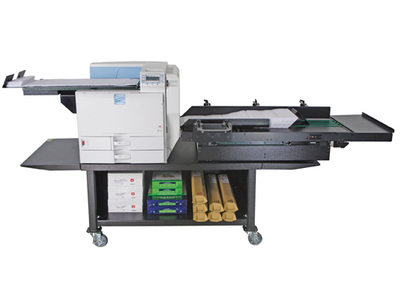The Xanté Impressia Digital Multi-Media Press
Xanté’s Impressia can be paired with a high speed feeder for envelope printing, but it has many more capabilities that make it a true multi-media press.
Ask Richard Ogando, director of Xanté reseller Tecnico Solutions, what the ideal customer is for the Xanté Impressia Digital Multi-Media Press, and you discover that you have asked what he says is the ‘million dollar question’.
‘We thought it would be DM printers doing short run campaigns that would be the key market for the Impressia, but in fact we are finding that there is no real niche target audience for it,’ he told Digital Printer. ‘We are talking to DM printers, small commercial print bureaux, high street printers, and big commercial printers, because they can all see the opportunity to bring in additional revenue with short run marketing material. It is really widespread.’
The printing system, which is a modified toner-based Ricoh engine, has a monthly duty cycle of 200,000 prints, is capable of printing up to 78 full colour DL envelopes per minute (4000 per hour) with a print resolution up to 2400 dpi, and has recently become available with a new high speed feeder, the Enterprise High Speed Feeder, which functions not through friction, as many feeders do, but through a flat belt conveyor system. ‘You drop the envelopes on the belt and away you go,’ said Mr Ogando. ‘It makes it really, really easy.’
The quality of output that is possible is causing the Impressia to be viewed as much more than just an envelope printing system though. It is quite capable of printing whatever goes into the envelope too, and according to Mr Ogando is an ideal system to run alongside a larger production press.
‘It’s not in the same bracket as some of the production printers but what’s interesting from our point of view is that one client that purchased an Impressia for envelopes started having some problems and down time with their production printers, so they started putting marketing leaflets and flyers on the Impressia. When they had a look at the quality, it was compatible and with certain jobs they felt they were getting a better finish,’ he reported.
It is also a very reliable and robust machine, Mr Ogando noted, pointing out that maintenance contracts are completely optional for customers, since so much can be easily self-maintained and almost every other issue can be resolved over the phone. Extra training is given during installation to make users as self-sufficient as possible.
Tecnico sees two main selling points to the Impressia, which was launched around 18 months ago. These are its flexibility and the iQueue software it comes with.
‘The biggest selling point is the flexibility with the envelope feeder, enabling users to produce a complete campaign on one machine with variable data, variable images, QR codes etc.,’ he said. ‘Second is the iQueue software, which is a really powerful tool, giving end users the ability to do many things, including spot colour creation, profiling, and colour matching. In fact, the software seems to be the thing that drives the sale actually, rather than the printer. You start talking about the printer and its capabilities and when you demo the software that really does the deal in the end.’
Indeed, the latest version of iQueue – the soon-to-be-released version 9 – includes a universal print driver, enabling it to drive any PostScript printer, not just Xanté systems. Also included are more intelligent and powerful variable data capabilities, and direct in-RIP support for Intelligent Mail barcodes. Other useful features from previous versions include real-time job cost estimating, full imposition and tiling, a QR code generator, and individual screening for CMYK and spot colours.
The Impressia costs £6000 for a standalone printer, rising to £10,495 for a full system with the Enterprise High Speed Feeder, stand, and duplexing capability. Running costs are also controlled through a pay-as-you-go scheme for toner, rather than a click charge. Black toner costs £39, colour is £85.
‘The costs are another great selling point,’ said Mr Ogando. ‘The yields on the toners are very good, which makes it very competitive compared to a click charge contract on a similar machine. You can get a mono print with 5% coverage for less than a penny. It is one of the most cost effective digital multi-media presses in the market, and with the software it is a print shop in a box.’





